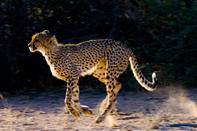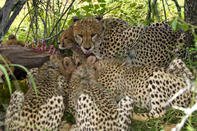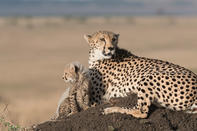The Cheetah (Acinonyx jubatus) derives its name from the Hindi word “Chita”, which means “spotted one” because of the round black spots on its tawny to gold coloured coat.

They have small heads with high set eyes and short rounded black ears with white tips. A black line that looks like tear tracks, run from the inner corner of the eye to the corner of the mouth and helps to absorb glare during day-time hunting. Their tails are long, black spotted with black rings towards the white tip of the tail.
Their strong slender build enables them to run up to 120 km/h making them the fastest land animals on earth. Females are slightly smaller than the males, with adult animals measuring 1.8 m to 2.2 m long and weighing 40 kg to 60 kg. Cheetahs are classified as one of the Lesser and not the Greater Cats, because they do not have a floating hyoid bone in their necks and do not roar but make a chirping sound when excited.
It is one of the only cat species that does not have fully retractile claws, so the impression of the claws will be visible in the tracks. They have been known to swim, although they do not particularly like it, and are poor climbers, although they may use trees with sloping trunks or branches to rest or use as a lookout.
The males are not particularly territorial and may move over areas held by several females. Apart from lions, they are the only other cat species in Africa that will form a group, usually consisting of a female and her litter or up to three males from the same litter. Females, however, generally only associate with other adult cheetahs during the mating season, which can be anytime during the year. The gestation period lasts around 92 days, with about four cubs being born per litter.
After birth, cubs are sheltered in tall grass or hidden in the underbush. The cubs are born with a mantle of fur running from the back of the neck to the rump, which helps to camouflage them. 90% of cubs die before they are three months old, with about half being destroyed by predators.
The other 40% suffer from weak and underdeveloped immune systems due to a lack of genetic diversity. Cheetahs are known to be of the easiest exotic cat species to tame and have been used as hunting partners for sport for over 5 000 years. They, unfortunately, do not breed well in captivity.
Killing and Feeding Pattern

Cheetah primarily hunt by day, usually during the early morning or late afternoon. They prefer to live in open grasslands, savannas, dense vegetation and sometimes even mountainous terrain, because they usually stalk their prey for only a short distance before chasing it.
Once caught, large prey are suffocated with a bite to the jugular while smaller prey might be killed with a quick bite to the head. They will eat quickly after killing an animal, since they are unable to defend their food from other predators. The rib ends of the prey will be chewed off and the skin, bones and entails will be left. Cheetah do not return to a kill nor do they eat carrion.
Management

Cheetahs are a protected species, so may not be killed. Of the 100 000 that roamed Africa, parts of the Middle East and Central Asia by the turn of the twentieth century, fewer than 7 500 are still left in the wild and fewer than 1 000 are still to be found in South Africa.
To address predation problems, the Predation Management Forum's manual advises farmers to build a kraal with branches and place a live Boer goat in the kraal as bait. A cage trap should then be placed at the entrance of the kraal to capture the cheetah.
Nature Conservation should be contacted to relocate the cheetah once it has been caught. Alternatively, the cheetah may be tranquilised and relocated. Jackal proof fencing, which is mesh fence that is about 1.2 m high with an opening of 74 mm, or electric fencing, noise, light and scent deterrents, kraaling of animals, the use of shepherds and guard animals may all help to prevent losses.
By Glenneis Kriel